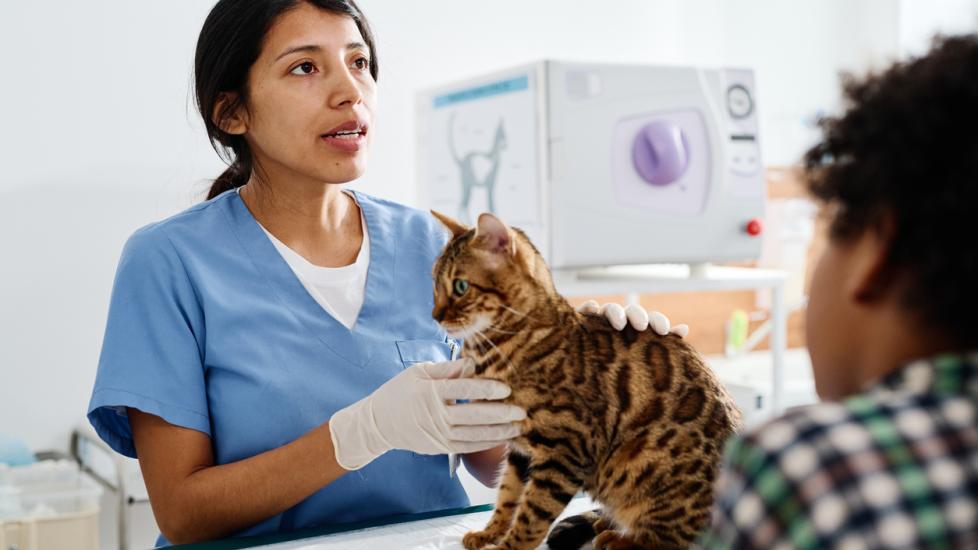Cushing's Disease (Hyperadrenocorticism) in Cats
What Is Cushing’s Disease in Cats?
Hyperadrenocorticism is commonly referred to as Cushing’s disease. It is uncommon in cats, caused by an excessive production of the hormone cortisol. Cortisol is naturally released from the adrenal glands in stressful or fearful situations, and is often referred to as the “stress hormone.” The two adrenal glands are located in the abdomen, near each kidney.
Health Tools
Not sure whether to see a vet?
Symptoms of Cushing’s Disease in Cats
Excessive cortisol concentrations can cause a variety of changes, including:
-
Excessive drinking
-
Excessive urination
-
Increased appetite
-
Recurrent urinary tract infections
-
Enlargement of the abdomen (a “potbellied-pig” appearance)
-
Lethargy
-
Muscle wasting and weakness
-
Hair loss
-
Curling of the ear tips
-
Thin and fragile skin that easily tears
-
Bruising
Causes of Cushing’s Disease in Cats
Hyperadrenocorticism is caused by high doses of cortisol-like hormones over a long period of time. Usually, these steroids (for example, prednisone) are used to control chronic conditions like allergies and asthma. Cats are less prone to developing the adverse effects of steroids, so this presentation of hyperadrenocorticism is rare.
Naturally occurring excessive levels of cortisol are also uncommon in cats. This condition is diagnosed in middle-aged and older cats (5–17 years old). Female cats are affected more than males, and domestic short- and longhaired cats more than purebreds.
Cats with hyperadrenocorticism may also have diabetes mellitus. The excessive cortisol from the adrenal glands interferes with the effects of insulin, causing diabetes. In fact, hyperadrenocorticism can make it difficult to regulate insulin dosages for a cat with diabetes.
How Veterinarians Diagnose Cushing’s Disease in Cats
Since hyperadrenocorticism is uncommon in cats and does not have a single “direct” test, diagnosis requires repeat blood tests, urine tests, and diagnostic imaging, like x-rays or ultrasounds. Tests used in combination to make the diagnosis of hyperadrenocorticism include:
-
Baseline Lab Work: This blood test checks liver and kidney values for function and counts red and white blood cell numbers. This helps to rule out more common causes of the clinical signs, after which more specific tests for hyperadrenocorticism are conducted.
-
Urine Cortisol Measurements: This screening test, performed on multiple urine samples, helps to rule out hyperadrenocorticism. High levels alone do not confirm a diagnosis, so further tests are required to support a diagnosis of hyperadrenocorticism.
-
ACTH-Stimulation Test: This blood test measures cortisol levels before and after an injection of ACTH, the adrenocorticotropic hormone. An injection of ACTH should cause the body to temporarily increase the production of cortisol, then decrease production once the body’s threshold has been met. Consistently high concentrations of cortisol in these samples usually confirm a diagnosis of hyperadrenocorticism.
-
Dexamethasone Suppression Test: This blood test measures cortisol levels before and after an injection of dexamethasone, a steroid. The injection should decrease the production of cortisol. High concentrations of cortisol (indicating a lack of suppression) in these samples usually confirm a diagnosis of hyperadrenocorticism.
-
Imaging: X-rays can show other changes to the liver and/or abdomen that may support a diagnosis of hyperadrenocorticism. An ultrasound helps to determine whether one or both adrenal glands are affected. Computed tomography (CT) or magnetic resonance imaging (MRI) of the cat’s head may show a mass on the pituitary gland, which is responsible for the regulation of hormones from the adrenal glands.
Treatment of Cushing’s Disease in Cats
With hyperadrenocorticism, treatment involves a controlled gradual withdrawal of the steroid that is being administered. Alternative drugs will be started if still needed, based on the underlying disease the steroid was treating—for example, to manage allergies or asthma.
With naturally occurring hyperadrenocorticism, treatment options vary. Control of the abnormal cortisol levels is obtained by:
-
Medications: Trilostane is best to suppress cortisol production from the adrenal glands. Tablets are given by mouth once or twice daily and are adjusted according to each cat’s response. Clinical signs may improve only minimally, even after the cortisol level is in a normal range.
-
Surgery: An adrenalectomy is the surgical removal of an adrenal gland. If only one adrenal gland is affected, this may be a good treatment. A hypophysectomy is the surgical removal of the pituitary gland (the regulator of the adrenal glands). This is an extremely difficult surgery that carries very high risks and is provided by only a few specialists.
-
Radiation: Radiation is best for pituitary gland tumors and cats with neurological signs such as stumbling, drooling, and seizures.
Recovery and Management of Cushing’s Disease in Cats
Cats with hyperadrenocorticism who respond well to the removal of the offending steroid and receive alternate medications will have an improved quality of life.
Naturally occurring hyperadrenocorticism does not have a cure, but it can be managed. Prognosis for cats with hyperadrenocorticism varies greatly and relies on their access and response to treatment. Most cats that can receive therapy have an improved quality of life. Cats with the successful removal of adrenal tumors, if present, have the longest survival times, although the surgery itself has a high complication rate.
Cushing’s Disease in Cats FAQs
Is Cushing’s disease fatal in cats?
Although hyperadrenocorticism is a serious disease, with appropriate treatment a cat can respond well and may have many months or even years with an excellent quality of life. If the underlying cause is a tumor, the prognosis is worse. When untreated, hyperadrenocorticism can be fatal.
Featured Image: iStock.com/shironosov
Help us make PetMD better
Was this article helpful?
